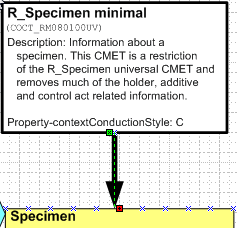Difference between revisions of "RMIM Designer Documentation (2010 Update)"
| Line 10: | Line 10: | ||
==Designating Context Conduction Style== | ==Designating Context Conduction Style== | ||
| + | During 2010, HL7 reviewed and completely restructured the methodology by which a serialized static model designates whether important context data applied to one element of the model also applies to "children" (in the serial hierarchical sense) of that element. | ||
| + | |||
| + | This change in context conduction control - deprecation the prior "conduction-indicator-based" method and adoption of a new "vocabulary-based" method - created the requirement to be able to designate '''for each model''' which of the methods it uses, or whether it uses neither. It was further determined that this designation would be documented as a "property" of the Entry Point for that model in its RMIM designs. | ||
| + | [[Image:ContextConductionStyleInAnEntryPoint.gif|||right||Context Conduction Style Property in an Entry Point Description]] | ||
| + | The designation is made by asserting one of three code values: | ||
| + | * '''"C"''' designates the model uses the original conduction-indicator-based method of establishing context conduction, a method that was deprecated during 2010. | ||
| + | * '''"V"''' designates the model uses the new vocabulary-based method of establishing context conduction as adopted during 2010. | ||
| + | * '''"I"''' designates that the model does not explicitly establish context conduction. This designation is formally "discouraged." | ||
| + | |||
| + | The figure at right shows the property asserted in the description of the Entry Point for CMET COCT_RM080100UV. The syntax is identical tho that used for asserting RIM properties in the descriptive text for attributes, etc. It is the Reserved fragment "'''''Property-'''''" followed by the property name "'''''contextConductionStyle'''''" followed by a colon and then the code "'''C'''" | ||
| + | |||
| + | '''Your Toolsmith does NOT recommend that you edit these by hand!''' (Except perhaps to delete one.) | ||
| + | ===Visio RMIM Designer Tool Support=== | ||
| + | |||
| + | |||
| + | |||
| + | |||
| + | |||
| + | |||
| + | As models evolve, many of them (particularly those developed before 2010) are using the "inferred (I)" designation. While there is an easy way to [[RMIM_Designer_Documentation_%282010_Update%29#Designating Context Conduction Style|establish context conduction style]], changing the designation once made is cumbersome. Switching this option from "false" to "true" will cause the RMIM Designer logic to automatically seek user approval to change the designation code for any model designated as "inferred." | ||
| + | |||
| + | The final option disallows a value of "inferred (I)" as a context conduction style. Disallowing this option provides an easy way to detect all models for which an expressed method of context conduction has not been declared. (See 2010/11 Updates tab.) | ||
| + | |||
==Options to "Scan" and "Repair" Designs== | ==Options to "Scan" and "Repair" Designs== | ||
==Aligning GUIDs on Shape Masters== | ==Aligning GUIDs on Shape Masters== | ||
Revision as of 00:41, 12 February 2011
| Overview | 2010/11 Updates | VocabMIF | DataTypeReleases | BatchProcess | CommandLine | Errors/Install | Vis2002-3-7-10-13 |
Introduction
This tab documents a set of important changes made in 2010 and 2011 that do not handily fall into other documentation categories.
Designating Context Conduction Style
During 2010, HL7 reviewed and completely restructured the methodology by which a serialized static model designates whether important context data applied to one element of the model also applies to "children" (in the serial hierarchical sense) of that element.
This change in context conduction control - deprecation the prior "conduction-indicator-based" method and adoption of a new "vocabulary-based" method - created the requirement to be able to designate for each model which of the methods it uses, or whether it uses neither. It was further determined that this designation would be documented as a "property" of the Entry Point for that model in its RMIM designs.
The designation is made by asserting one of three code values:
- "C" designates the model uses the original conduction-indicator-based method of establishing context conduction, a method that was deprecated during 2010.
- "V" designates the model uses the new vocabulary-based method of establishing context conduction as adopted during 2010.
- "I" designates that the model does not explicitly establish context conduction. This designation is formally "discouraged."
The figure at right shows the property asserted in the description of the Entry Point for CMET COCT_RM080100UV. The syntax is identical tho that used for asserting RIM properties in the descriptive text for attributes, etc. It is the Reserved fragment "Property-" followed by the property name "contextConductionStyle" followed by a colon and then the code "C"
Your Toolsmith does NOT recommend that you edit these by hand! (Except perhaps to delete one.)
Visio RMIM Designer Tool Support
As models evolve, many of them (particularly those developed before 2010) are using the "inferred (I)" designation. While there is an easy way to establish context conduction style, changing the designation once made is cumbersome. Switching this option from "false" to "true" will cause the RMIM Designer logic to automatically seek user approval to change the designation code for any model designated as "inferred."
The final option disallows a value of "inferred (I)" as a context conduction style. Disallowing this option provides an easy way to detect all models for which an expressed method of context conduction has not been declared. (See 2010/11 Updates tab.)
